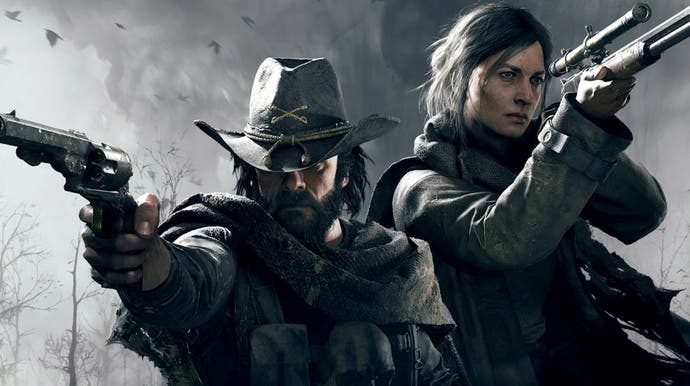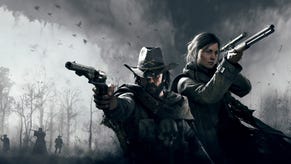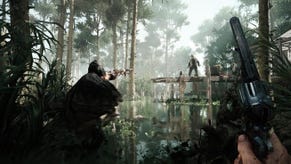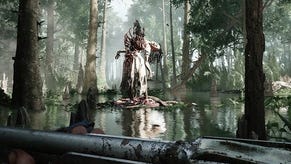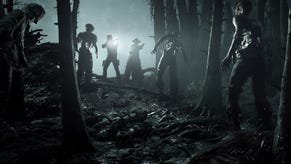Hunt: Showdown review - a sweaty, stinking, cat-and-mouse masterpiece
Drain the swamp.
A rough beast indeed, Hunt: Showdown, slouching toward the daylight after a couple of years in Early Access. A genre chimera, blurring survival horror with boss rush shooter and battle royale, not quite one thing, not quite another.
At a glance you might confuse it with Far Cry 2 - there's the same malarial background hum, the same flammable brown palette - but in motion it's closer to PUBG, shunning the clear ground, ears pricked for proximity chat. It has the vivid markings of a Monster Hunter, but those patterns are really just for show, like the eye-whites of a killer whale - masking the gunsights protruding from its abdomen. You certainly wouldn't call it handsome, but you can't seem to drag your gaze away. How did something so... multiple ever survive the evolutionary process? But alas, you've looked for too long. It knows you're there now. No, don't try to run! The creature's girth is deceptive. We'll have to see if we can bring it down.
If Hunt: Showdown's unusual - and, as it turns out, fantastically exhilarating and engrossing - mixture of inspirations has a single guiding principle, it's that predators become prey. It's a game in which stepping on a twig while chasing a zombie can get you shot from a hundred yards off, and the time-honoured ceremony of a bossfight offers zero defence against the player lobbing dynamite through a window.

In Hunt, you play patron to a "Bloodline" of bounty hunters, all seeking their fortune amid the rot of a 19th century Louisiana that has been overrun by demons. Your task, in the main bounty-hunting mode, is to find the lair of a legendary monster within one of two festering open world maps, using your sorcerous Dark Vision to chase swirling blue sparks to clues that narrow down the search area. Having slain and exorcised the abomination, you must collect a bounty and head to a map exit to complete the match. Along the way you'll fight or avoid myriad lesser horrors - from vanilla zombies who can be treated as speed bumps, providing you don't overlook the ones waving cleavers or torches, to chunkier threats such as the Meathead, a one-armed juggernaut that sees by way of a slithering entourage of leeches.
You'll earn both character XP and coin for slaying these minor foes, but every bullet or firebomb wasted on a demon dog (and every bandage applied to your shredded flesh after discovering that the dog has friends) is one less to pit against the boss itself. There are three of them, right now - you never know which you're up against before starting a match, so it's wise not to specialise too much when equipping guns and consumables. The Butcher is the soft option, for all its bulk: a porcine bully armed with a flaming hook, easily slaughtered providing you keep your distance. The knife-wielding Assassin is wilier, dissolving itself into a cloud of flies in order to course through the crevices of barns and windmills; it can even clone itself to distract you, like a lizard discarding its tail. Worst of all, though, is the Spider, a viciously nimble wall-crawler that always seems to be behind or above you, its rattling feet setting your hairs on end. Many hours after first killing one, I still feel the urge to stand on a chair while fighting it.
Thankfully, bosses never leave their lairs, so you can always hurry outside to patch yourself up, scrounge some ammo or take potshots at your quarry through a gap in the boards. Except that you can't, actually, because the sting in Hunt's tail is that it's a competitive affair. There may be other players in the vicinity - as many as a dozen per match, questing in groups of up to three. Enemy players aren't marked on the HUD or map screen to begin with, but it's easy to give yourself away while thinning the NPC herd, and as in Turtle Rock's sadly forgotten Evolve, each map is awash with nefarious ambient warning systems such as patches of broken glass, clattering chains and flocks of tetchy crows. The bossfights, naturally, tend to involve a lot of telltale screaming and explosions, and once you've killed the boss, you must banish it to obtain the bounty - a two-minute exorcism ritual that flags your position on the map, giving rivals all the time they need to close in and set up a perimeter. Bounties themselves are visible on the HUD along with their carriers, which often makes exfiltration the most arduous part of the match.

It's a recipe, all told, for two kinds of dread. On the one hand, there's the revulsion you feel toward creatures who used to be regular folks and animals: the women whose chests have split to reveal mosquito hives; the men who resemble giant, groaning lumps of decaying coral. This is a fear that abates as you play match after match, memorising AI aggro ranges and unlocking new gear and skills such as blunt impact resistance or faster crossbow reloads. Beyond the first 10 Bloodline levels, hunters and their gear are lost forever when slain, but they are just as swiftly replaced, with one free greenhorn recruit available on the roster screen between matches (you can also buy "Legendary" hunters with real money, but the perks are strictly cosmetic). You learn not to grow too attached, though you can always extract from a round early if you feel totally outgunned.
Which means that it's all about the second kind of dread, the all-pervading, remorseless awareness that at any given moment, somebody could be aiming a gun at you, somewhere out there in the sweaty blur of undergrowth, reading your position and direction in birdsign, the splashing of your feet (why on earth did you take that shortcut through the swamp?) and the hungry twitching of nearby zombies. It's a horror that can't be denied or hidden from, alleviated only by the sheer malice you feel when you hear a cough, turn slowly and spy another player galloping heedlessly through a cornfield with their microphone on.
You may have felt similar emotions while playing venerable MMO shooter DayZ - Hunt's achievement, perhaps, is to take that game's ethos of treachery and paranoia and pack it into rounds of 30-40 minutes apiece, with a clear, overarching rhythm of exploration, battle and escape. That's 30-40 minutes at the outside: if there are 12 players in the field, it's not uncommon to bump into rivals within the first few minutes. If you're luckier, you might be the one player who doesn't bumble into that gunfight and wind up all on your lonesome, farming the map's denizens at your leisure. But of course, you can never guarantee that you're the last person standing. If you plan on going loud it's safest to pair up, as team-mates can revive one another at the cost of the permanent loss of a health bar segment.
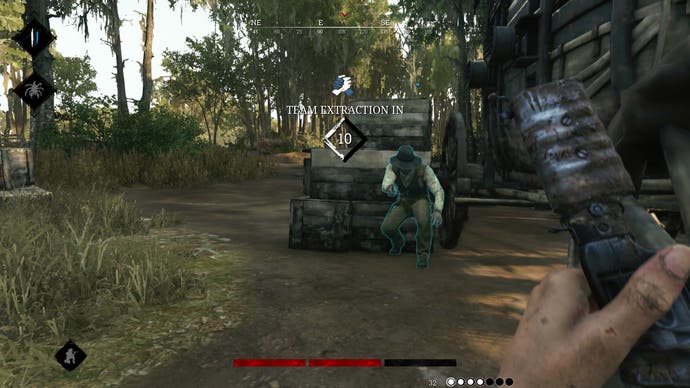
That fear of being watched teaches you to savour the devious intricacy of Hunt's environment design. Every feature of this benighted landscape is the basis for some kind of tactical dilemma. Buildings harbour ammo or health refills, but that also means you're more likely to encounter other players there. Randomly applied misty or night time conditions lessen the anxiety when breaking cover, but dial it up again when defending a lair during the banishment - it's wise to douse the lanterns before risking a peek out the window. You might want to make more active use of those ambient alarm systems, perhaps tripping a generator to drown out any sounds you make while sneaking up on a camper.
Boss lairs, especially, assume a twofold existence in your mind. There's the trepidation of invading them, particularly when battling the Spider, whose form - like the Xenomorph - is hard to make out against thickets of rusting farm tools and the entangled shadows of beams. And then there's the process of defending them during or after a banishment, whereupon you become the lurking terror, reading the minds of invaders. A woman's yell downstairs indicates that one nearby player has roused a zombie's wrath. A creak above suggests that another - allied to the first? - is tip-toeing across the tiles. A distant burst of cawing reveals that a third is approaching from the north. If the dice fall your way, that approaching player might snipe the one on the roof while you pounce on the first player below. But you're not really worrying about players 1, 2 and 3. The player you're worried about is player 4, the one you haven't detected yet, the one you must always assume is there.
I'm not sure I've played a multiplayer game that breeds such tension since Rainbow Six: Siege. Hunt's drawback, if you can call it that, is that it doesn't offer much alternative to that tension. You can't play solo against the AI, save for revisiting the game's opening training level (Crytek is working on a proper solo PvE mode), and while there's a boss-less Quickplay option, this isn't quite the emergency release valve for pent-up jitters it sounds like. Rather, it's a very nifty extension of the character levelling system.
In Quickplay, you're handed a random, cursed hunter and must track down three energy sources in order to activate a mystic wellspring and escape the map. Where in bounty hunt, new guns can only be looted from dead hunters, in Quickplay you'll find exotic weapons dotted all over. You'll also acquire a random skill for every energy source you tap. The result is a custom-created hero, endowed with choice gear and abilities that might be beyond your current Bloodline rank. Survive the ordeal, and you can recruit that character to your roster. The catch is that only one hunter can activate the wellspring and escape - and there's nothing like the rage when you've cobbled together your very own Van Helsing and another player yanks the rug away with an exploding crossbow bolt.
Long in the brewing - it began life at Crytek USA as a kind of Grimm fairytales spin on Left 4 Dead - Hunt: Showdown cuts a strange, skulking figure alongside the multiplayer shooters that dominate discussion today. It's resolutely one-note, though each bounty hunt throws up a variety of deadly surprises, and profoundly unforgiving. Beyond that 10 level grace period it has no real interest in making you feel at home. That sheer impassivity, however, stokes emotions you simply won't find in most multiplayer games. The way your pulse jumps when you catch the echo of gunfire. The bile in your throat as you monitor the Spider's motions through the woodwork of a barn. And above all, the horrible triumph when a flock of birds take off nearby, and you aim your shotgun just as somebody peers around a wall.
